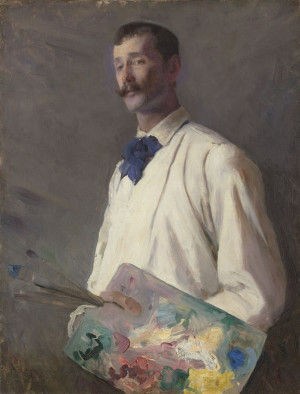Thomas-Alexander Harrison ( - )

After studying in 1871-1872 with Georges W. Pettit at the Pennsylvania Academy of the Fine Arts in his native Philadelphia, Harrison spent six years as a draftsman on a government mapping expedition along the Pacific coast. In 1879, he left the United States to settle in France, accompanied by his two brothers, themselves painters, Birge Harrison (1854-1929), a pupil of Luc-Olivier Merson, and Butler Harrison (died 1886). Pupil of Gérôme and Bastien-Lepage.
Alexander Harrison soon made a name for himself with works whose subjects were somewhat anecdotal, but which were conducive to remarkable light studies. Soon, however, the painter devoted himself almost exclusively to the sea, with great success. He is sometimes considered the leader of American painters in Paris, and opened a studio to prepare his compatriots for the 1889 Universal Exhibition, at which he won a medal. He was awarded the Légion d'Honneur the same year. A member of numerous art juries and committees, Harrison exhibited at the Vienna, Munich and Berlin Sécessions and was one of the most influential foreign artists in Paris.
In 1893, La Solitude, which combines a nocturnal lakescape with a poetic nude, was acquired by the French State at the Salon de la Société nationale des Beaux-Arts. The painter discovered Brittany very soon after his arrival in France. Harrison's desire to depict wide open spaces led him to visit the Bay of Concarneau rather than Pont-Aven. It was in Beg-Meil, above all, that the artist found material for his studies of light and color. The long beaches that separate the tip of Beg-Meil from Bénodet are ideal for boundless contemplation.
We know that the painter was close to the young Marcel Proust, and that he frequented him at Beg-Meil. The future author of À la recherche du temps perdu came there for several summers in a row in the mid-1890s, in the company of composer Reynaldo Hahn. Both a model for the painter's character Elstir, and also for certain descriptions of the sea that seem inspired by his paintings, the artist seems to have impressed the writer, who recalls him when writing À l'ombre des jeunes filles en fleurs.
In the beautiful marine in the Quimper collections, perhaps painted at Beg Meil, Harrison chooses the nocturne to evoke, once again, the infinite nuances of sea and sky.